19 Anubias Varieties Unveiled: Popular Types for Aquariums & Quick Stats
Tough, elegant, and almost impossible to kill—Anubias plants have earned a well-deserved reputation as the aquascaper’s best friend. Whether you’re setting up a lush planted tank or just want something hardy for your beginner aquarium, Anubias delivers beauty without the need for high maintenance. With their rich green leaves, slow growth, and low lighting needs, these plants thrive in a wide range of setups. In this guide, we explore some of the most popular Anubias varieties that can transform your aquarium—both aesthetically and ecologically.
- Anubias barteri var. barteri
- Anubias barteri var. nana
- Anubias nana 'Petite'
- Anubias nana 'Golden'
- Anubias barteri 'Coin Leaves'
- Anubias barteri 'Coffeefolia'
- Anubias gracilis
- Anubias barteri 'Angustifolia' – A. lanceolata
- Anubias congensis (afzelii)
- Anubias heterophylla
- Anubias Heterophylla Supernova
- Anubias Chili Jalapeno
- Anubias hastifolia
- Anubias minima
- Anubias pinto
- Anubias nana 'Snow White'
- Anubias nana 'Petite White'
- Anubias gigantea
- Anubias 'Stardust'
Anubias barteri var. barteri
- Scientific name: Anubias barteri var. barteri
- Position: Midground, background
- Care level: Easy
- Growth rate: Slow
- Height: 8-16 inches (20-40 cm)
- Lighting: Low to moderate
- CO2: Not required, optional for faster growth
Anubias barteri var. barteri is renowned for its broad, heart-shaped leaves that bring a lush, vibrant green to aquariums. Its robust, leathery foliage makes it a striking addition, often serving as a focal point in larger tanks due to its substantial size, with leaves reaching up to 3 inches long and a plant width of up to 16 inches. This variety is highly versatile, thriving in both submerged and emersed conditions, making it ideal for aquariums and paludariums alike.
In aquascaping, Anubias barteri var. barteri is commonly attached to rocks or driftwood, where its thick rhizome anchors securely, creating a natural, jungle-like aesthetic. Its durability and resistance to herbivorous fish make it a favorite for setups with species like African cichlids or goldfish, adding long-lasting structure and color to the tank without requiring frequent maintenance.
Anubias barteri var. nana
- Scientific name: Anubias barteri var. nana
- Position: Foreground, midground
- Care level: Easy
- Growth rate: Slow
- Height: 2-6 inches (5-15 cm)
- Lighting: Low to moderate
- CO2: Not required, optional for enhanced growth
Anubias barteri var. nana is the most popular variety of Anubias, cherished for its compact size and dense, dark green leaves that grow to about 2-3 inches long. Originating from Cameroon, this dwarf variety reaches a height of 5-10 cm, making it perfect for smaller aquariums or as a foreground to midground plant in larger setups. Its small stature and slow growth add a refined, tidy appearance to any aquascape.
This variety excels when attached to hardscape elements like stones or wood, where its short-stemmed leaves create a carpet-like effect. Anubias barteri var. nana is a go-to choice for aquarists seeking a low-maintenance plant that provides excellent cover for fish and shrimp while maintaining a clean, polished look in the tank. Its widespread use stems from its adaptability and ability to thrive in varied conditions.
Anubias nana ‘Petite’
- Scientific name: Anubias barteri var. nana ‘Petite’
- Position: Foreground
- Care level: Easy
- Growth rate: Very slow
- Height: 1-2 inches (2.5-5 cm)
- Lighting: Low to moderate
- CO2: Not required
Anubias nana ‘Petite’ is one of the smallest Anubias varieties, with tiny, oval leaves typically under 1 inch long, making it ideal for intricate, detailed aquascapes. Its diminutive size and clustered growth pattern give it a delicate, bonsai-like appearance, perfect for nano tanks or foreground accents in larger aquariums. This plant’s compact form adds a sense of scale and precision to layouts.
In aquascaping, Anubias nana ‘Petite’ shines when tied to small pieces of driftwood or rocks, creating miniature tree-like structures that enhance the tank’s aesthetic. Its ability to thrive in low-light conditions and resist nibbling from most fish makes it a versatile choice for aquarists aiming for a refined, meticulous design without sacrificing hardiness.
Anubias nana ‘Golden’
 Anubias barteri nana Golden #ad
Anubias barteri nana Golden #ad
- Scientific name: Anubias barteri var. nana ‘Golden’
- Position: Foreground, midground
- Care level: Easy
- Growth rate: Slow
- Height: 2-4 inches (5-10 cm)
- Lighting: Low to moderate
- CO2: Not required, optional for better coloration
Anubias nana ‘Golden’ stands out with its vibrant, lime-green to golden leaves, a rare and eye-catching variation of Anubias barteri var. nana. Its bright foliage, typically 2-3 inches in size, contrasts beautifully against darker hardscape or other plants, making it a standout feature in any aquarium. This variety’s unique coloration adds a pop of brightness to shaded areas.
When used in aquascaping, Anubias nana ‘Golden’ is often placed on driftwood or rocks to highlight its luminous leaves, creating a striking visual effect. Its compact size and slow growth make it suitable for midground or foreground placement, where it can serve as a focal point or complement darker green plants, enhancing the overall vibrancy of the tank.
Anubias barteri ‘Coin Leaves’
 Anubias barteri Coin Leaves #ad
Anubias barteri Coin Leaves #ad
- Scientific name: Anubias barteri ‘Coin Leaves’
- Position: Foreground, midground
- Care level: Easy
- Growth rate: Slow
- Height: 4-8 inches (10-20 cm)
- Lighting: Low to moderate
- CO2: Not required
Anubias barteri ‘Coin Leaves’, also known as ‘Round Leaf’ or ‘Golden Coin’, features distinctive round, slightly heart-shaped leaves that set it apart from other Anubias varieties. Its unique leaf shape, resembling small coins, and lush green color make it a rare and visually appealing addition to aquariums, growing to a height of about 5-15 cm.
This variety is often used as a midground or foreground plant, attached to hardscape elements to emphasize its unusual leaf shape. Its compact growth and exotic appearance make it a favorite for aquarists looking to add a touch of uniqueness to their tank, creating a focal point that complements more traditional plant shapes in the aquascape.
Anubias barteri ‘Coffeefolia’
- Scientific name: Anubias barteri ‘Coffeefolia’
- Position: Foreground, midground
- Care level: Easy
- Growth rate: Slow
- Height: 4-6 inches (10-15 cm)
- Lighting: Low to moderate
- CO2: Not required, optional for faster growth
Anubias barteri ‘Coffeefolia’ is distinguished by its textured, wrinkled leaves with a dark green surface and a reddish-brown underside, giving it a unique, coffee-like aesthetic. Growing up to 12 inches tall, its ridged foliage adds depth and character to aquariums, making it a standout choice for aquascapers seeking visual variety.
In tank setups, ‘Coffeefolia’ is often placed in the midground, where its bold texture and coloration can form natural hedges or accentuate driftwood and rocks. Its striking appearance and ability to thrive in shaded areas make it ideal for creating a lush, tropical ambiance, particularly in community tanks with shrimp or small fish.
Anubias gracilis
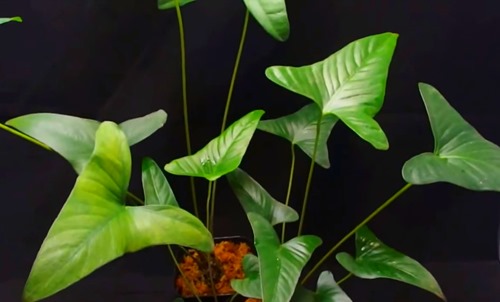
- Scientific name: Anubias gracilis
- Position: Midground, background
- Care level: Moderate
- Growth rate: Slow
- Height: 8-12 inches (20-30 cm)
- Lighting: Low to moderate
- CO2: Not required
Anubias gracilis is characterized by its elegant, triangular, arrow-shaped leaves with dark veins, offering a sophisticated and graceful look. Native to West Africa, this medium-sized plant can reach up to 12 inches in height, with long, slender stems that give it a distinctive, upright growth pattern compared to other Anubias species.
In aquascaping, Anubias gracilis is often used in the midground or background to add a sense of height and elegance. Its pointed leaves and neat appearance make it perfect for attaching to driftwood or rocks, where it creates a refined, natural look that enhances the tank’s depth and aesthetic appeal.
Anubias barteri ‘Angustifolia’ – A. lanceolata
- Scientific name: Anubias barteri var. angustifolia
- Position: Midground, background
- Care level: Easy
- Growth rate: Slow
- Height: 6-12 inches (15-30 cm)
- Lighting: Low to moderate
- CO2: Not required
Anubias barteri ‘Angustifolia’, also known as Anubias lanceolata, features long, narrow, lance-shaped leaves that give it a sleek, sword-like appearance. Growing up to 12 inches tall, its elongated foliage and deep green color make it a versatile choice for larger tanks, where it adds a dynamic, vertical element to the aquascape.
This variety is often attached to rocks or driftwood in the midground or background, where its slender leaves contrast with broader-leafed plants, creating a balanced and visually appealing layout. Its durability and unique shape make it a favorite for aquarists aiming to craft a sophisticated, tropical underwater scene.
Anubias congensis (afzelii)
- Scientific name: Anubias congensis (syn. Anubias afzelii)
- Position: Midground, background
- Care level: Moderate
- Growth rate: Slow
- Height: 12-20 inches (30-50 cm)
- Lighting: Low to moderate
- CO2: Not required
Anubias congensis, sometimes referred to as Anubias afzelii, is distinguished by its slender, upright leaves that can grow up to 15 inches tall, giving it a statuesque presence in aquariums. Its narrow, lance-shaped foliage, typically dark green, adds a vertical dimension to aquascapes, making it ideal for creating a sense of height and structure in larger tanks.
In aquascaping, Anubias congensis is often attached to driftwood or rocks in the midground or background, where its erect growth and delicate leaves create a striking, forest-like effect. Its robust nature and ability to thrive in low-light conditions make it a versatile choice for aquarists looking to add elegance without complex maintenance.
Anubias heterophylla
- Scientific name: Anubias heterophylla
- Position: Background
- Care level: Moderate
- Growth rate: Slow
- Height: 12-24 inches (30-60 cm)
- Lighting: Low to moderate
- CO2: Not required
Anubias heterophylla is notable for its large, broad leaves that resemble terrestrial plants, giving it a unique, almost hybrid appearance in aquatic settings. Growing up to 24 inches tall, its lush, green foliage can dominate larger tanks, providing a bold, tropical aesthetic that stands out in any aquascape.
This species is often used in the background of aquariums or paludariums, where its substantial leaves can be anchored to hardscape elements like rocks or logs. Anubias heterophylla’s ability to grow both submerged and emersed makes it a flexible choice for aquarists aiming to create a natural, verdant look with a hint of terrestrial charm.
Anubias Heterophylla Supernova
 Anubias Heterophylla Supernova #ad
Anubias Heterophylla Supernova #ad
- Scientific name: Anubias heterophylla ‘Supernova’
- Position: Midground to background
- Care level: Easy
- Growth rate: Slow
- Height: 8 – 16 inches (20 – 40 cm)
- Lighting: Low to medium
- CO2: Optional
Anubias Heterophylla Supernova is a rarer variant of the Anubias genus, characterized by vibrant green leaves that are nearly twice the length of standard Anubias Heterophylla, often displaying unique venation and a slightly wavy texture. Growing up to 20 inches tall, its large, bold foliage makes it a versatile choice for both midground and background placement in medium to large aquariums.
In aquascaping, Anubias Heterophylla Supernova is best affixed to hardscape elements like stones or driftwood, where its substantial leaves add depth and a lush, tropical aesthetic. Its ability to thrive in low to moderate light and adapt to both submerged and partially emersed conditions makes it a robust, visually impressive option for aquarists aiming to create a dramatic, naturalistic tank environment.
Anubias Chili Jalapeno
- Scientific name: Anubias sp. ‘Chili Jalapeno’
- Position: Midground
- Care level: Easy
- Growth rate: Slow
- Height: 3 – 5 inches (7 – 12 cm)
- Lighting: Low to medium
- CO2: Optional
Anubias Chili Jalapeno is a rare hybrid of Anubias Chili and Anubias Minima, known for its distinctive, small, jalapeño-shaped leaves that exhibit a rich green tone, occasionally with subtle white-green variegation. Its compact size, typically reaching 3-5 inches in height, and unique leaf shape make it a captivating addition to nano aquariums, where it adds a playful yet elegant touch to the aquascape.
This plant is ideal for midground placement, often attached to driftwood or rocks, where its petite, elongated leaves create a dynamic, textured effect. Anubias Chili Jalapeno’s hardy nature and adaptability to both submerged and emersed conditions make it a favorite for aquarists seeking a low-maintenance plant with a striking, unconventional appearance suitable for small-scale layouts.
Anubias hastifolia
- Scientific name: Anubias hastifolia
- Position: Background, suitable for paludariums
- Care level: Moderate
- Growth rate: Slow
- Height: 16-24 inches (40-60 cm)
- Lighting: Low to moderate
- CO2: Not required
Anubias hastifolia is characterized by its large, spear-shaped leaves that resemble arrowheads, making it a dramatic addition to spacious aquariums or semi-aquatic setups like paludariums. With leaves that can extend up to 20 inches, this species is one of the larger Anubias varieties, offering a bold and imposing presence.
In aquascaping, Anubias hastifolia is typically placed in the background of large tanks, where its distinctive leaf shape adds a sense of grandeur. It is often attached to substantial pieces of driftwood or rocks, creating a focal point that enhances the tank’s depth and complements other plants in expansive layouts.
Anubias minima
- Scientific name: Anubias minima
- Position: Foreground, midground
- Care level: Easy
- Growth rate: Slow
- Height: 4-8 inches (10-20 cm)
- Lighting: Low to moderate
- CO2: Not required
Anubias minima is a smaller variety with elongated, slender leaves that grow up to 4-6 inches, offering a soft, flowing appearance in aquariums. Its graceful, wavy foliage and compact size make it a popular choice for aquarists seeking to add a delicate, natural touch to their setups without overwhelming the space.
 Anubias Minima Dragon Claw #ad
Anubias Minima Dragon Claw #ad
This plant is often used in the foreground or midground, tied to small rocks or driftwood, where its gentle, undulating leaves create a sense of movement. Anubias minima’s versatility and subtle beauty make it a favored option for nano tanks or as a complementary plant in more complex aquascapes.
Anubias pinto
- Scientific name: Anubias barteri var. nana ‘Pinto’
- Position: Foreground, midground
- Care level: Moderate
- Growth rate: Very slow
- Height: 2-4 inches (5-10 cm)
- Lighting: Low to moderate
- CO2: Not required, optional for better variegation
Anubias pinto is a rare, variegated mutant with distinctive cream-white speckled leaves, making it a prized choice for aquarists seeking a unique accent plant. Its small size, typically under 4 inches, and striking marbled pattern add a touch of elegance and exclusivity to any aquarium, particularly in detailed layouts.
In aquascaping, Anubias pinto is often placed in the foreground or attached to hardscape to highlight its vibrant, spotted foliage. Its rarity and slow growth make it a standout feature, perfect for creating focal points in nano or mid-sized tanks where its unique coloration can shine.
Anubias nana ‘Snow White’
- Scientific name: Anubias barteri var. nana ‘Snow White’
- Position: Foreground
- Care level: Moderate to difficult
- Growth rate: Very slow
- Height: 1-2 inches (2.5-5 cm)
- Lighting: Low to moderate
- CO2: Not required, optional for stability
Anubias nana ‘Snow White’ is an exceptionally rare variety with almost entirely white leaves, a result of its low chlorophyll content, which gives it a ghostly, ethereal appearance. Growing to just 2-3 inches, this slow-growing plant is highly sought after for its striking, alabaster look, though its delicate nature requires careful placement.
This variety is typically used as a centerpiece in small tanks or nano setups, often attached to dark rocks or driftwood to emphasize its pale coloration. Anubias nana ‘Snow White’ adds a surreal, artistic touch to aquascapes, making it a coveted choice for collectors and enthusiasts.
Anubias nana ‘Petite White’
 Anubias barteri var. nana White #ad
Anubias barteri var. nana White #ad
- Scientific name: Anubias barteri var. nana ‘Petite White’
- Position: Foreground to midground
- Care level: Moderate
- Growth rate: Slow
- Height: 1 – 2 inches (2 – 5 cm)
- Lighting: Medium to high
- CO2: Optional
Anubias nana ‘Petite White’ is an extremely rare and visually striking variety, characterized by its tiny, almost entirely white leaves due to minimal chlorophyll content. With leaves typically under 1 inch long and a compact height of 1-2 inches, this plant’s delicate, alabaster appearance makes it a standout in nano aquariums or intricate aquascapes, offering a unique, almost otherworldly aesthetic.
In aquascaping, Anubias nana ‘Petite White’ is often used as a focal point in small setups, attached to dark rocks or fine driftwood to highlight its ghostly coloration. Its slow growth and petite size make it ideal for meticulous layouts, where it adds a touch of elegance and exclusivity, captivating aquarists seeking rare, high-impact plants.
Anubias gigantea
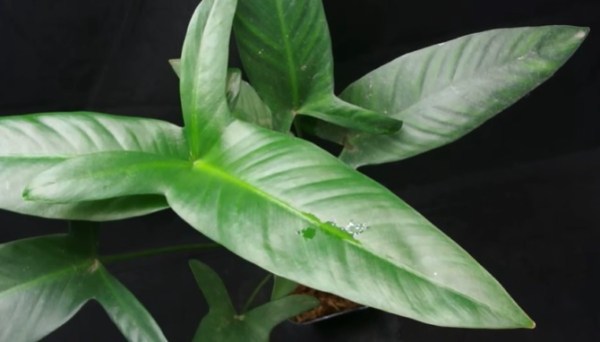
- Scientific name: Anubias gigantea
- Position: Background, large tanks
- Care level: Moderate
- Growth rate: Slow
- Height: 12-36 inches (30-90 cm)
- Lighting: Low to moderate
- CO2: Not required
Anubias gigantea is one of the largest Anubias species, with broad, leathery leaves that can exceed 30 inches in height, making it a rare and imposing addition to oversized aquariums. Its massive size and robust, dark green foliage create a commanding presence, ideal for dramatic, large-scale aquascapes or paludariums.
In aquascaping, Anubias gigantea is best suited for the background of expansive tanks, where it can be anchored to large hardscape elements to create a jungle-like atmosphere. Its rarity and bold structure make it a standout choice for aquarists designing grand, naturalistic underwater scenes.
Anubias ‘Stardust’
- Scientific name: Anubias barteri var. nana ‘Stardust’
- Position: Foreground, midground
- Care level: Moderate
- Growth rate: Very slow
- Height: 2-4 inches (5-10 cm)
- Lighting: Low to moderate
- CO2: Not required, optional for enhanced variegation
Anubias ‘Stardust’ is a newer, variegated variety similar to Anubias pinto, featuring leaves with white, star-like speckles scattered across a green base. Its compact size, typically under 5 inches, and unique pattern make it a visually captivating addition to aquariums, offering a fresh take on variegated Anubias.
This plant is often used as a foreground or midground accent, tied to rocks or driftwood to showcase its distinctive, speckled foliage. Anubias ‘Stardust’ adds a sparkling, modern aesthetic to aquascapes, making it a popular choice for aquarists seeking to incorporate rare, eye-catching plants into their designs.

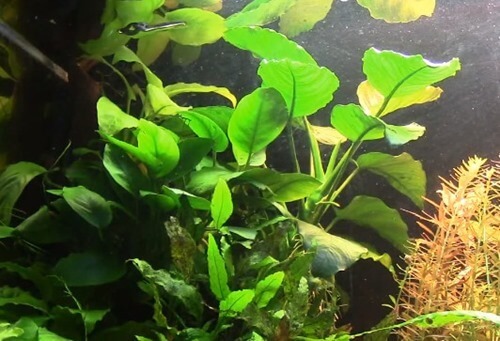 Anubias barteri #ad
Anubias barteri #ad Anubias nana #ad
Anubias nana #ad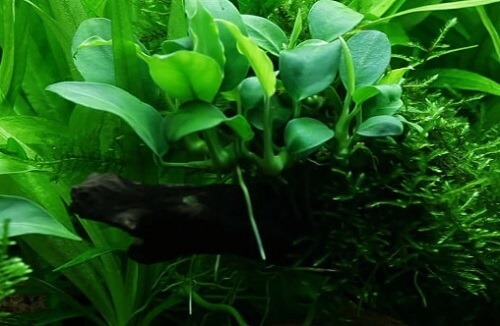 Anubias nana petite #ad
Anubias nana petite #ad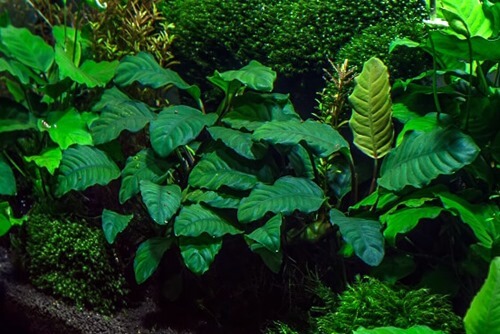 Anubias Coffeefolia #ad
Anubias Coffeefolia #ad Anubias lanceolata #ad
Anubias lanceolata #ad Anubias congensis #ad
Anubias congensis #ad Anubias heterophylla #ad
Anubias heterophylla #ad Anubias Chili Jalapeno #ad
Anubias Chili Jalapeno #ad Anubias hastifolia #ad
Anubias hastifolia #ad Anubias minima #ad
Anubias minima #ad Anubias pinto #ad
Anubias pinto #ad Anubias nana Snow White #ad
Anubias nana Snow White #ad Anubias Stardust #ad
Anubias Stardust #ad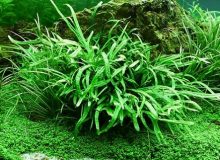
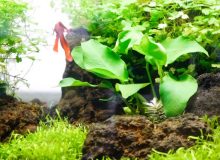
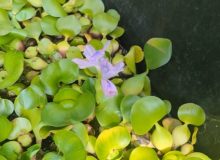
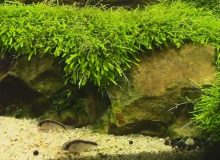

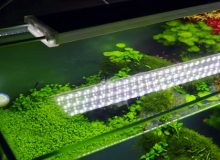
Leave a Reply